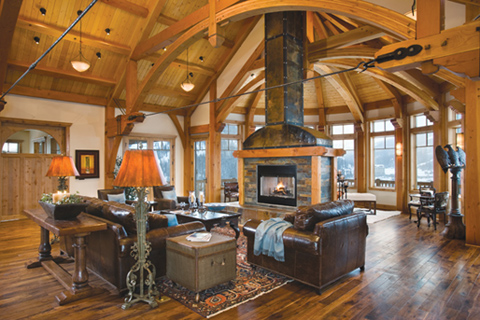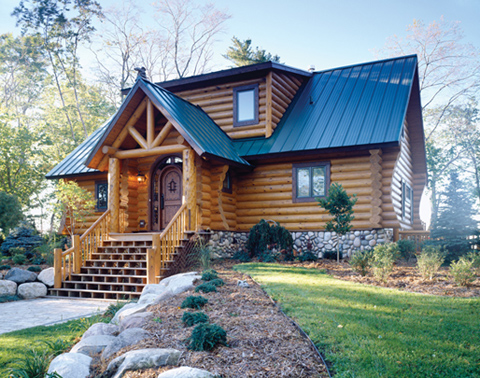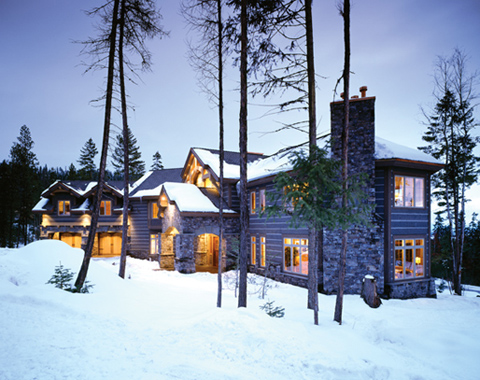Once upon a time a house was deemed a necessity for protection from natural occurrences, such as the weather or wild animals. It was a simple structure; something that would be built quickly with supplies available in close proximity to the building site. Today a “home” still protects you from the elements and the occasional wild animal, but it has evolved, morphing into a statement about each individual homeowner and his or her personal tastes. From choosing the building site to the floorplan to the interior design, a log home presents numerous design choices for a homeowner. Yet, there is one important factor that may influence the overall home more than one may think: log style.
“Certain log styles are more predominant in certain areas of the country,” says Mathew Sterchi, vice president of sales and marketing at StoneMill Log & Timber Homes in Knoxville, Tennessee. “Every region has log styles that people gravitate to because that’s what they are used to seeing in a particular area. Some individuals want to be unique, though, and want something that is not typical for the region. Those home owners want their home to be a statement of who they are and what their lifestyle is all about.”
Once you know where you are planning to build, you need to answer the next question: What is my style and how will my log home represent it? Although you may notice a predominance of a certain style in your area of the country, don’t limit yourself to what you see locally.
“There are numerous design styles to choose from. In one area of the country you may see a lot of natural wood accents, whereas in another area you may see a lot of full, round logs. Either way, you’re getting a custom home that no one else can really duplicate,” says Mikel Ochs, marketing development manager for Rocky Mountain Log Homes in Hamilton, Montana.

Photo by Karl Neumann
A Variety of Styles
Log styles can vary in a number of ways, including the types of logs used to the construction methods used for those logs. Corner styles and notching methods are other considerations that can impact the look of a home. When it comes to the types of logs available, log companies may offer types such as handcrafted logs, hewn logs, sawn logs, or milled logs. Logs can also be divided among different drying methods, including standing dead logs, air-dried logs, kiln-dried logs, and green logs. Construction methods might include Scandinavian full-scribe, flat-on-flat, milled, or butt-and-pass.
But the elements that make up the home’s appearance don’t stop there. Corner elements can also play a part in the overall feel and function of a home. Corner styles include saddle-notch, dovetail, butt-and-pass, interlocking, or vertical corner posts.
“Corner detail lends itself to log style and is an important consideration,” says Sterchi. “Certain corner notches/designs architecturally lend themselves to certain log styles. However, there are corner styles that have better structural integrity and better resistance to weather as well. It’s an important factor when choosing a style to look at the corner detail that is associated with that log style. Make sure both are structurally and architecturally conducive to the design you’re creating.”
With all those terms coursing through your consciousness and creating a wealth of options, it may be easier to find pictures of styles you like and then consult a log home specialist to determine the pros and cons behind those styles and whether they will work in your project.

Hiawatha Log Homes/photo by Roger Wade
Other Considerations
Besides personal taste, another important factor in deciding which style to build with relates to the environmental factors of your building site, including local climate, precipitation, temperature ranges, and wind patterns. Although many years ago the types of logs used in a home might have been determined by what was available within a small radius of a building site, nowadays, just about any type of wood can be shipped across the country. Using a native species is still a good idea, though, as wood that is native to a particular area will have more natural protection against regional climate conditions and pests.
“Climate can impact the type of wood species you use dramatically,” says Sterchi. “When you get into Florida, cypress and cedar are more common, whereas in the Pacific Northwest, Douglass fir and cedar are more common. Certain wood species work better in certain climate zones because of susceptibility, durability, and natural resistance to rot and decay while in their native environment.”
It is important to take plenty of time for the preliminary planning stage and consider all elements as they come together. Beside the logs, other elements of the home can play a part in the overall design and function, including roof lines, roof materials, porches, chinking, windows, etc.
“We build a lot of homes internationally and a lot of times, it’s the area that determines the designs and materials you’re going to include in your home,” Ochs says.
In addition to climate, stricter building codes and energy codes may play a role in deciding what your final design may encapsulate.

Tomahawk Log & Country Homes/photo by Roger Wade
“Particular log styles are what people are drawn to and although you can still have the look of a rectangular log with chinking, how we get that look has changed. To keep up with increasing energy and building code requirements, thicker log walls are being used and innovative products such as log-sided framed walls with high R-value insulation have been created to help cater to these code requirements in certain regions of the country,” says Sterchi. “In essence, we’ve transformed the way we get the log look of old.”
An Artist’s Eye
From the very beginning, a log home starts as a blank canvas and it’s up to the homeowner to turn it into his or her artistic masterpiece. A home’s log style is just one important element that adds a bit of color to that canvas, thus helping create the final piece: a one-of-a-kind log home.
“There is no one size fits all style and there is not one log style that fits every single region of the country,” says Sterchi. “The number one decision about log home style is what is most appealing to you. The majority of log home buyers purchase based on the look and feel, and how the home fits into their lifestyle. As much as we want to make it technical and recommend the best log styles, it all comes down to the look you like best.”

